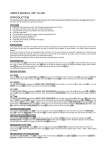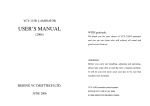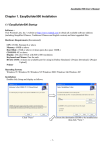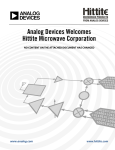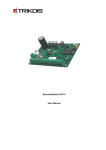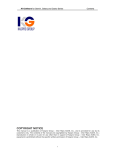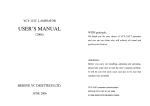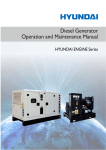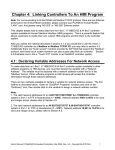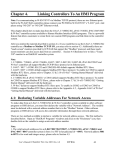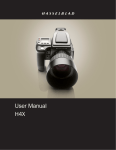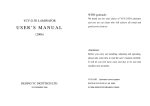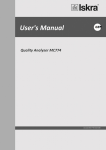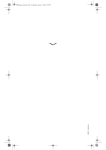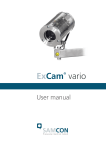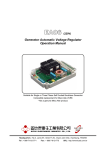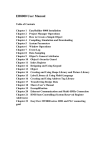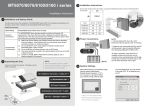Download EasyView500
Transcript
EasyView500 32BIT RISC CPU Professional Human Machine Interface ??MT508S / MT506S / MT506L User Manual Weintek Labs., Inc. EasyBuilder 500 User Guide 1. STARTUP ................................................................................................................................................ 5 1.1 THE FIRST STEP ........................................................................................................................................5 1.2 EASY BUILDER SCREEN EDITOR FUNCTIONS........................................................................................8 1.3 CREATING A NEW PROJECT ....................................................................................................................10 2.FUNDAMENTALS .....................................................................................................................................20 2.1 ID NUMBERS...........................................................................................................................................21 2.2 A TTACHING A DESCRIPNTION................................................................................................................21 2.3 ENTERING PLC READ/WRITE ADDRESS ...............................................................................................21 2.4 SELECTING A SHAPE...............................................................................................................................23 2.5 SELECTING A BMP.................................................................................................................................24 2.6 CREATING LABELS .................................................................................................................................25 2.7 P ROGRAMMING TASK BUTTONS...........................................................................................................28 2.8 W INDOWS................................................................................................................................................31 2.9 W INDOW SELECTION BAR ....................................................................................................................35 2.10 A DD A SHAPE TO THE LIBRARY ...........................................................................................................36 2.11 A DD BMP TO THE LIBRARY ................................................................................................................37 2.12 GROUP LIBRARIES................................................................................................................................37 3. PARTS ...........................................................................................................................................................40 3.1 BIT LAMP.................................................................................................................................................40 3.2 W ORD LAMP ...........................................................................................................................................41 3.3 SET BIT ....................................................................................................................................................42 3.4 SET W ORD...............................................................................................................................................44 3.5 TOGGLE SWITCH.....................................................................................................................................47 3.6 M ULTI-STATE SWITCH ...........................................................................................................................48 3.7 FUNCTION KEY........................................................................................................................................49 3.7.1 Change Window...........................................................................................................................50 3.7.2 Return to Previous.......................................................................................................................50 3.7.3 Change Common Window ..........................................................................................................50 3.7.4 Character Codes and Creating a Keypad................................................................................50 3.7.5 Move Window ...............................................................................................................................51 1 EasyBuilder 500 User Guide 3.7.6 Minimize Window.........................................................................................................................52 3.7.7 Popup Window..............................................................................................................................52 3.7.8 Close Window...............................................................................................................................52 3.7.9 JOG FS-Window ..........................................................................................................................53 3.7.10 Message Board...........................................................................................................................53 3.8 M OVING SHAPE ......................................................................................................................................54 3.9 A NIMATION..............................................................................................................................................56 3.10 NUMERIC INPUT ...................................................................................................................................58 3.11 NUMERIC DATA ....................................................................................................................................63 3.12 ASCII INPUT .........................................................................................................................................64 3.13 ASCII DATA..........................................................................................................................................66 3.14 BAR GRAPH...........................................................................................................................................67 3.15 M ETER...................................................................................................................................................69 3.16 INDIRECT W INDOW ..............................................................................................................................70 3.17 DIRECT W INDOW .................................................................................................................................72 3.18 A LARM SCAN........................................................................................................................................74 3.19 A LARM DISPLAY...................................................................................................................................75 3.20 TREND DISPLAY ....................................................................................................................................77 3.21 A LARM BAR ..........................................................................................................................................80 3.22 RECIPE TRANSFER................................................................................................................................81 3.23 EVENT DISPLAY....................................................................................................................................83 3.24 DATA TRANSFER...................................................................................................................................85 3.25 EVENT LOG ...........................................................................................................................................87 3.26 PLC CONTROL .....................................................................................................................................89 3.27 SYSTEM MESSAGE ...............................................................................................................................91 4. DRAWING...................................................................................................................................................92 4.1 LINE/RECTANGLE/CIRCLE /ELLIPSE /A RC/POLYGON .........................................................................92 4.2 TEXT.........................................................................................................................................................93 4.3 SHAPE.......................................................................................................................................................94 4.4 BMP.........................................................................................................................................................94 4.5 S CALE.......................................................................................................................................................94 2 EasyBuilder 500 User Guide 5. EFFECTIVE ASSISTANCE FUNCTION..........................................................................................95 5.1 GRID/SNAP ..............................................................................................................................................95 5.2 W INDOW PROPERTY SETTING...............................................................................................................95 5.3 LANGUAGE ..............................................................................................................................................96 5.4 OBJECT ATTRIBUTE................................................................................................................................96 6. EDIT FUNCTIONS ...................................................................................................................................97 6.1 SELECTING OBJECTS..............................................................................................................................97 6.2 M OVE OBJECTS.......................................................................................................................................97 6.3 A LIGN OBJECTS......................................................................................................................................97 6.4 S CALE OBJECTS......................................................................................................................................97 6.5 GROUP /UNGROUP OBJECTS..................................................................................................................98 6.6 BRING TO FRONT / SEND TO BACK .......................................................................................................98 6.7 CHANGE CHARACTER SIZE....................................................................................................................98 6.8 CUT, COPY AND PASTE..........................................................................................................................98 6.9 CHANGING ATTRIBUTES ........................................................................................................................98 6.10 UNDO .....................................................................................................................................................98 6.11 REDO ......................................................................................................................................................98 6.12 RESIZING OBJECTS...............................................................................................................................99 APPENDIX I - PARTS (OBJECTS) SUMMARY...............................................................................100 APPENDIX II – ERROR MESSAGE ....................................................................................................102 3 EasyBuilder 500 User Guide 4 EasyBuilder 500 User Guide 1. Startup 1.1 The First Step Set up the MT500 with PC and PLC as depicted below. a) connect PC[RS-232] port of the MT500 to the PC. Since the PC[RS-232] and PLC[RS-485] share the same D-SUB connector , it is recommend to use MT5_PC to split it into two separate connectors at debug process. b) connect either PLC[RS-485] or PLC[RS-232] port of the MT500 to the PLC. (Please check the PLC signal type and cable listing in the back of this manual to assure proper port connections.) MT510 Reset Button Dip Switch Reset Button Contrast Contrast Dip Switch MT506 PLC(RS-485) PC (RS-232) PLC(RS-232) PLC(RS-485) PC (RS-232) PLC(RS-232) PRINTER MT5_PC cable PC To PLC To PLC RS-485 Interface RS-232 Interface c) Set Dip Switch at all “OFF” position (factory default setting). 5 EasyBuilder 500 User Guide d) Connect DC 24V power to the power connector. Fail to connect the right pole may cause fuse in the MT500 burn out. e) Apply power and calibrate contrast adjust VR to the best viewing performance. (For MT500S only, not applicable for MT500T) f) Install EasyBuilder 500 on your PC and enter EasyManager after you finish the installation process. The Easy Manager is a software shell program for EasyBuilder : screen editor to configure EasyView MT5xx HMI (abbreviated as EB500). EasyWindow: simulate EasyView on the PC, after the project is complied by EB500(file with extension *.eob), the EasyWindow will retrieve the data from PLC through the EasyView and simulate the operation of EasyView on the PC screen. Using the Simulator on your debug process will save on time spent in repeat downloads. EasyView communicator: download/upload project and switch operation mode. Download :Download the project complied by EB500 to the EasyView. Upload : Upload the project image from EasyView to an object file (*.eob). The upload file cannot be opened by EB500 but can be transferred to another EasyView. This is useful for retrieving data from installed units to make a duplicate setup. Mode Change: The EasyView operates in three modes: RDS (Remote Debug & Simulation) mode: Used for simulation and download/upload. 6 EasyBuilder 500 User Guide Application (On line operation) mode: This is the normal operating mode of the EasyView, the EasyView will start from the startup window of the project download. Touch Adjust (Touch screen calibration) mode: Used to calibrate the touch screen. The EasyWindow and EasyView communicator can also be invoked by EasyBuilder, however the communication setting (between PC and EasyView) is defined on the EasyManager as follows: COM Port : selecting the COM port that connected with the EasyView. Comm. Speed : to determine the communication speed between the PC and the EasyView during download and upload operations. Project Download/Upload or Recipe Download/Upload: to determine which data is sent or retrieved from the EasyView. Project: All Project related files Recipe: recipe data Full or Partial Download/Upload: This is only for project download/upload, “Full” means project files and application program , “Partial” means project files only. Now click the EasyBuilder button. The following popup dialog appears. Select the appropriate model that you are programming . 7 EasyBuilder 500 User Guide 1.2 EasyBuilder Screen Editor Functions Clicking on the Easy Manager’s [EasyBuilder] button will cause the following screen to appear. The functions of each screen area are explained below. a. Title bar c. Tool bar b. Menu bar d. State selector e. Alignment f. Object resize g. Position adjust h. Group / ungroup i. Layer control j. Text size and position k. Rotate & flip l. Part tool box m. Window / Object selection tree n. Drawing tools o. Cursor Position a. Title Bar Displays the project’s file name, window number and title. b. Menu Bar Displays the menu used to select EasyBuilder commands. Selecting one of these causes the corresponding pull down menu to appear. c. Tool Bar Displays the icons corresponding to the File, Edit, Library, Compile, Simulation and Download command. 8 EasyBuilder 500 User Guide d. State selector Clicking on this button toggles all the parts on the screen to a specified state. e. Alignment Make all the selected parts line up to the top, bottom, left or right. f. Object resize It makes the dimension, width or height of all the selected part to the same size. g. Position adjust Adjust the position of selected parts. h. Group / ungroup The group function makes a collection of selected parts and drawing elements as one object. i. Layer control Adjust the Layer of selected part – one layer up, one layer down, to top layer and to bottom layer. j. Text size & position Change the font size and alignment of the selected text. k. Rotate and flip Allows shapes to be flipped horizontally or vertically and rotated in 90 degree increments. l. Parts tool box Icons representing each part type are shown. Clicking on one of these icons causes that icon’s dialog box to appear. That part’s attributes can then be set and the part can be placed on the screen. m. Window and object selection tree It provides a convenient way to select a window or a specified project. n. Drawing tool Icons representing each drawing tool are shown. Availa ble drawing tools include line, rectangle, ellipse/circle, arc, polygon, scale, bit map graphics and shape. o. Cursor position Shows the current cursor position on the active window. 9 EasyBuilder 500 User Guide 1.3 Creating a new project A project file ( .epj ) is simply a collection of all the windows and configured objects on the windows. In the File menu, select [New] and model of MT touch screen and a new project will be created. 1) Fill in system parameter In the Edit menu, select [System Parameter] and the following screen will appear. 10 EasyBuilder 500 User Guide Within this screen, there are three tabs, [PLC] , [General] and [Indicator]. Choosing [PLC] tag to setup parameters to link with PLC, choosing [General] tag to setup the system configuration of the project and choosing [Indicator ] tab to set attribute of system indicator. PLC Tab PLC type : select appropriate PLC type from the available PLC selection menu. Hardware version: To select the version of the MT touch screen to which the created project will be downloaded. Serial port I/F : Select the port connected with PLC, either RS-232 or RS-485 . Baud rate, Parity, Data bits and Stop bits : Set the communication parameter to match with PLC. MT station No. : This is used when multiple MTs can connect to the PLC link, for example for AB DH485 or Unitelway driver, it is possible to connect multiple to the PLC link, each MT has to be set different station No. Set it as 0 when not used. PLC station No. : Used when PLC has a node or station No. Set it as 0 when not used. Multiple HMI : Allows more than one MT to be connected to one PLC, even PLC has only one communication port. Disable : Disable chaining of multiple MT to one PLC Master : Select this when the MT is the unit connected directly to the PLC Slave : Select this when the MT connect to the precedence MT. HMI-HMI line speed : Set appropriate communication speed between master MT and slave MT, both shall set the same speed. The EasyView is able to support master - slave communication feature for every PLC it supports. All the EasyView are connected one by one and the first one connects with the PLC. The one EasyView which connects directly with PLC is configured as master. All the other EasyView which connect to preceding EasyView and retrieves PLC data through preceding HMI are configured as slave. In theory there is no limitation for number of EasyView on a chain, however response time will gradually decrease when more than three EasyView are linked together in a chain. 11 EasyBuilder 500 User Guide Wiring cable between EasyView SLAVE HMI PLC[RS-232] D-SUB male 2 TD 3 RD 5 GND MASTER HMI PC[RS-232] D-SUB female 8 RD 7 TD 5 GND Configuration Multiple HMI : Set “Master” for the MT500 connects with PLC, set “Slave” for the rest of the MT500. HMI-HMI line speed : select either 38400 or 115200 . Note: all the EasyView in the link must set the same link speed. When [multiple HMI] is set as “slave”, the EasyView will ignore those communication parameters connect with PLC (serial port I/F, baud rate, ..) . It will always use PLC[RS-232] to retrieve data from preceding EasyView. PLC time out constant (sec.) : The parameter determine how long the MT will wait for the response from the PLC. This setting is required when the PLC is slow in response. Normal time out constant is set as 3.0 seconds. PLC block pack : The MT will automatically collect all continuous PLC data and send read command, it greatly increase efficiency of communication and improve response time. However if data is not continuous then the MT will read it by separate commands. The PLC block pack set allowable gap between configured addresses, even two data is not continuous in address, however if the difference is not greater than PLC block pack then MT still read pack those data in one command and read it from the PLC. 12 EasyBuilder 500 User Guide General Tab Task Button : The Task button is used to pop up the fast display window or display the icon bar. Minimized window’s icons are put on the icon bar. Attribute : Enables or disables this feature. If disable the fast window and task bar are not available at run time. Background color : select background color of the task bar. No. of min. windows : Set the number of windows that can be minimized to the task bar. Position : determines the position of task button, in left or right. Text : determines if the text displayed in the minimized window icons is centered or left adjust. Alarm Bar : The alarm bar rotate all the alarm message one by one . Pixels per scroll : set the number of pixels of the alarm message to scroll ( 8, 16, 24 or 32 pixels), the larger the number the faster a given message will be displayed. 13 EasyBuilder 500 User Guide Scroll speed : set the time interval to scroll, the smaller the number the faster the alarm message are displayed. Startup window No. : This is the window displayed on the screen when MT startup. Backlight saver : The MT turn off back light if there are no touch operations in preset time ( range 1 to 30 minutes ). Set 0 disables the backlight saver function. Cursor color : Set the color of cursor when the Numerical Input is activated for data entry. Buzzer : Disable or enable buzzer operation, the buzzer will activate when the touch screen is pressed. Common Window : Common window is a window that overlay to the base window at any times. Popup window : set the attribute of popup window registered in the common window, it can be popped up as normal (i.e. the latest pop up window is always displayed on the top.) or on the top . Draw common window : set the common window above or below base window. Extra. No. of Event : The MT is set to accommodate up to 1000 event. If more than 1000 event are needed, the additional number of event is entered here. For example if 1200 event messages are needed, 200 shall be entered in the Extra No. of event. RTC source : set the source of time of date when event message is generated. The RTC data can be retrieved from local word or internal RTC. If local word is selected then it is necessary to set another DF (Data Transfer ) object to transfer actual RTC data from PLC to local word periodically. If internal RTC is selected, the optional recipe card must be installed in the CPU board. Print: Used to set printer protocol, enable the printing of time tag and sequence number when event message is printed out. 14 EasyBuilder 500 User Guide Printer : select the compatible printer driver for your printer. Print sequence number : enable the printing of a sequence number along with the event message. The sequence number is incremented each time a new event comes up. Print time tag: Enable the printing of time of date along with event message. Error detection : Set to ignore error signals ( such as no paper ) from the printer or hold transmission of printed data until error signals are cleared. Indicator Tab Touch Indicator: The touch indicator changes color when the screen is touched. Attribute : Enable or disable this feature. If disabled, the touch indicator is not displayed. Non-configured area, Active area, Inactive area and Frame : Set color for touch operations in each area of screen. CPU indicator: The CPU indicator is a bar graph that shows the percentage of CPU loading. Attribute : Enable or disable this feature, if disabled the CPU indicator is not 15 EasyBuilder 500 User Guide displayed. Color : Set color of CPU indicator. Alarm indicator: The alarm indicator is a bar graph that shows the number of alarm message exists, the bar graph display full scale if number of alarm above ten . Attribute : Enable or disable this feature, if disabled the CPU indicator is not displayed. Color : Set color of CPU indicator. 2) Select BMP and/or Shape Library to attach to the project In the Library menu, select [Shape, BMP or Group] ? [Call up Library] to call up library browser. EB500 provides three types of libraries: A Bitmap graphics (BMP) is a collection of pixel of data. EB500 supports up to 256 colors Bitmap graphics. A Shape is a collection of drawing elements, those elements, when put together, will define a graphic symbol representing a button, lamp, function key etc. A Group is a collection of objects. (i.e. A keypad would be a group of function buttons.) Click select Lib. To attach an existing library to the current project 16 EasyBuilder 500 User Guide A comparison of shape and BMP is illustrated below: Bit Map Graphics Shape Arbitrary Graphic Good Memory capacity Very large Limited to those graphics can be designed by basic drawing elements Small Effect of enlarge & shrink Display Speed* Fair to Bad Good Good Good The MT500’s 32 bit processor allows display speed of both bit map graphics and shapes to be extremely fast, even during enlarge and shrink operations. 3) Design the windows Use the parts and drawing elements, virtually any type of window display can be competed in 10 minutes. “Easy to Use” is the greatest benefit of our EasyBuilder screen editor software. 4) Save the project In the File menu, select [Save] or click on icon to save the project. 5) Compile the project In the Tool menu, select [Compile] or click on to compile the project file to the image file ( .eob FILE ) 17 EasyBuilder 500 User Guide 6) Simulate the project In the Tool menu, select [Simulate] or click on to start simulation. After the project is complied by EB500, the Simulator will retrieve the data from PLC through the MT500 and simulate MT500 operation. By using the Simulator before the project is completely debugged, a lot of time will be saved by avoiding repeated downloads. Before simulation, be sure to connect the MT500 and the PLC properly and set the COM port in the Easy Manager menu. EB500 also supports off line simulation, the off line simulation will not retrieve data from PLC and therefore all the data on the screen is static. 18 EasyBuilder 500 User Guide 7) Download the project In the Tool menu, select [Simulate] or click to load the image file into MT500. Before downloading, be sure to set the COM port in the Easy Manager menu. 8) Switch to Application Mode Go back to Easy Manager, click on [Jump to Application], the MT will enter online operation mode and the start up screen will be displayed. Improper programming: If the MT500 screen is programmed to access data from an invalid register or bit adress for the PLC, the unit receives an error message from the PLC. The unit interprets this as a loss in communications. Be sure that all data points registered in the window are valid for the PLC that is connected. This ends the Quick Start section. From here it is up to you to make the spectacular screen displays that will make life easier for your operators. 19 EasyBuilder 500 User Guide 2.Fundamentals Basically, a screen is composed of a variety of parts such as Switches, Lamps, Numerical data and Graphics. The procedure to add a part to the screen is just a simple 3 step procedure. Procedure to build up a Part. 1. Select a Part by either clicking on a Parts toolbox icon, or dragging over one of the [Parts] menu’s selections. 2. Once the Parts dialog box appears, set (enter) the Part’s attribute data, such as PLC read/write address, shape or BMP, and label as described in this section. 3. After all of a Part’s attributes have been set, simply click on the Finish button to place it on the current screen. If desired, use the Part’s sizing handles to adjust its size, or click on the Part to select it and drag it anywhere on the screen. A Bit Lamp Part’s Dialog Box 20 EasyBuilder 500 User Guide 2.1 ID Numbers An ID number is a code number that is assigned automatically to a Part. The number identifies a specific part on the current screen. The programmer cannot change the ID number. WL-001 Indicate part is Word Lamp Sequence number for the part 2.2 Attaching a Descripntion If desired, a comment can be attached to a Part. This is a good practice for future referencing and useful when deciphering a printout of project files. 2.3 Entering PLC read/write address The valid device type and address range depends on the individual PLC type. Select appropriate PLC type in the system parameter menu. 21 EasyBuilder 500 User Guide The device type field will indicate all possible devices available. Click icon show all the possible device Enter address here Devices reside in EasyView Internal memory Type Bit Bit Bit Bit Device Name LB RBI RB Ms_RB Range 0~9999 0h~4095h 0h~4095h 0h~4095h Bit Word Word Word Word Word MS_LB LW RWI RW Ms_RW MS_LW 0~9999 0~9999 0~4095 0~4095 0~4095 0~9999 Remark Address of local memory h=0~F, index address of recipe memory h=0~F, absolute address of recipe memory h=0~F, absolute address of Master HMI’s recipe memory. Address of Master HMI’s local memory Address of local memory index address of recipe memory absolute address of recipe memory absolute address of Master HMI’s recipe memory. Address of Master HMI’s local memory The RB is mapping to the same area as the RW, for example RB50..RB5F is mapping to the same location as RW5, while the LB is mapping to the different area from the LW. The local memory address above LW9000 is reserved for system use and user shall not use them as general purpose device. When the recipe memory is accessed by index address, the index address is offset from its indicated address by the content of LW9000. For examples if (LW9000)= 50, then an index address RWI 100 physically accesses the data at address RW 150 (100+50). 22 EasyBuilder 500 User Guide 2.4 Selecting a Shape 1. Click on the [Shape] tab 2. Select [Use shape] Click on [Shape Library]. The shape browser will pop up. The shapes are stored in a specified shape library ( SLB file ). A maximum of 10 shape libraries can be attached to a project. By calling up different shape libraries, useful shapes for almost any application can be found. Users can also build up their own shape library. Select any shape library attached to this project. Select the state to view each shape in the cell. Each cell can have a maximum of 32 shapes, the first shape in the cell represent zero (0), the second represent one(1) and so on. Toggle state selector to Select Lib New Lib Delete shape Export Attach an existing library to the current project Attach a new (blank) library to current project Delete all the shapes from the selected cell Export the shape to current screen (return to a group of draw objects) 23 EasyBuilder 500 User Guide 2.5 Selecting a BMP Click on the [Shape] tab Select [Use BMP] Click [BMP Library] The BMP browser will pop up. The BMP graphics are stored in a specified BMP library ( BLB file ). Each project is able to include 10 BMP libraries. By calling up different BMP library, a useful Select any Bitmap library attached to this project. Select the state to view each cell’s Bitmap. Each cell can have a maximum of 32 Bitmap graphics, the first Bitmap in the cell represents zero (0), the second represents one (1) and so on. Toggle the state selector to view each Bitmaps BMP library for almost any application can be found. Users can also build up their own BMP libraries. Select Lib New Lib Export Add bitmap Delete bitmap 24 Attach an existing library to the current project Attach a new (blank) library to current project Save the BMP to a file with *.bmp format Add BMP graphics to the specified cell Delete BMP graphics from the selected cell EasyBuilder 500 User Guide 2.6 Creating Labels A label means the text characters shown on the face of the Switch, Lamp or other objects (Parts). Adding a label to a Part 1. Click on [Label] tab 2. Select Attributes for the part 3. Select the state to label Click icon to select each state Select “Use Label” to enable label display 4. Type the state’s label in the Content box State States are displayed only for those parts with multiple states. The text displayed for each state can be set independently. Simply select a state in order to set its text, font, color and alignment. 25 EasyBuilder 500 User Guide Font A variety size of font is available – 8, 16, 24, 32, 48, 64, 72 and 96 Alignment (Justification) When the text input for a Label becomes more than two lines, the alignment can be defined as left, right or center justification. Color A maximum of 32 from 256 colors are available for selection, the “basic” palette includes the most commonly used colors. The “customized” palette allows the user to customize his preference color palette. Select color icon to customize the palette There are two color palettes, each consists of 128 colors Content Box Type in the characters to be displayed on the button in the Content Box. The “ENTER” key can be used to move to the next line if desired. 26 EasyBuilder 500 User Guide Position Once the Part is placed on the screen, the Label can be moved anywhere within the boundary of the object. Just click on the label and drag the mouse to move it to the desired position. Toggle through the state designator to display the predefined label in each state. Click on the object Click on the label Drag to move 27 EasyBuilder 500 User Guide 2.7 Programming Task Buttons Task Button Overview The EasyView 500 provides a method to pop up (maximize) or icon-ize (minimize) child windows and change window displays. Fast Select Window Expands out Window Bar Expands out Fast Select Window Window Bar Indicators If “Task button” is enabled, pressing the right-hand task button will pop up a fast selection window. The fast selection window can have several function keys (placed on it by the user) to change to different windows. Since the fast selection window is global to all windows, it can be called up at any time. To change windows, press the function key that targets the destination window. This avoids the tedious search and find process. The Window Bar accommodates up to six window icons. Double -clicking the minimize icon of a window will icon-ize the corresponding window. Clicking it again will return the window to its original location and size. 28 EasyBuilder 500 User Guide Procedure to Setup Task Buttons 1. On [Edit] menu ? Select [System Parameter]. Set [Task button] as Enable. Set the position of the task buttons to the left or right side of the window. Note: The task buttons will be visible at run time in the lower right or left corner of the display. The Task buttons are not visible when editing a window. 2. Click on the General Tab. Select the different drop downs to determine how the task bar will appear. Then, in the [Window] menu ? Select [Open Window] Press [Task button], then press [Window] or [Screen] buttons to customize how the Fast select button or Window bar button will look. 29 EasyBuilder 500 User Guide 3. Fill in the blanks of the Fast Window and Window Selection dialog The Fast Window dialog has the settings for the button that controls the bar where window icons are displayed. The Window Attribute dialog has the settings for the button that controls the popup Fast Window. Style: Set “Fast” or “Slow” to control the pop up speed. Shape: Define the shape of task button or window button just as you would any other button object. Label: Place a customized label on the task or window button. 30 EasyBuilder 500 User Guide 2.8 Windows The “Windows” are the basic element of EB500 project. Each screen is composed of a number of “windows”. When the change screen command is executed, the screen is clean up and the first window is displayed. The content of the common window will also be displayed on the screen. The pop-up windows invoked by direct or indirect window command will not change the original content of screen, it just pastes on the screen. Create a new window Every new project begins with a default window, window number 10. Usually more than one window is needed for a project. There are three types of windows – base, fast selection and common. Valid window numbers are from 10 to 999. Procedure to create a new Window On the [Window] menu select [Open Window] ? [New Window] ? [Base Window] or [Fast Selection] or [Common Window]. Select appropriate window style Base window : The base window is the normal window style. When the base window is invoked by a “change window” command, the screen will be clear up (except common window and Fast Selection window) and the window will be displayed on the screen. When the base window is invoked by a “pop up window” command, the original information on the screen will preserved and the window will be added to the screen.. 31 EasyBuilder 500 User Guide Fast Selection window : The fast selection window is the window invoked by task button, this window will be displayed on the screen unless it is closed by task button. Common window : The common window will always be displayed on the screen. It is convenient to register those objects need to be displayed on the screen at all times in the common window. Setup the window properties as follows: Name: Give each window a unique name in order to identify it. Window No: valid window number from 10 to 999 Start Pos.: When this window is popped up by the function key with “window pop up” attribute, the up-right corner of the window will be displayed in this position. Size: Set appropriate width and height if it is a pop up window, set full screen size if it is a base window. Style: Tracking, Monopoly ,Clipping and Coherence Those parameters specify the relationship between a window and its calling window. If a window is marked as monopoly then the calling window will be frozen when it is popped up. If a window is marked as Clipping then the calling window limits its boundary, this means the display area outside of the calling window will be cut off. If a window is marked as tracking , the window will be moved accordingly when its calling window is moved. If clipping is selected, the tracking must be selected too. 32 EasyBuilder 500 User Guide In the following both window A and window B is registered in a Base window. In the normal case if you touch window A it will be positioned to the top. If window A is marked with “coherence” attribute, the window A will not be positioned to the top even you touch it. Base window Window A Window B Base window Window A Window B Frame: A Frame is suggested for popup windows. The width of the frame can be selected from the drop down (0, 4, 6, 8, 10, 12, 14, 16) if the Frame is not 0, eight colors are available for the frame. Background: Select the background color and pattern for the window. Note: The window number and size is not changeable after window is created. 33 EasyBuilder 500 User Guide Opening Windows After a window is created, with the open window dialog box select it from the list and double click it or press [Open] to open the window. The windows with an * mark are already opened. To edit a window that has already been opened, just select [Window] menu then select the window. Modify Window Properties On the [Window] menu, select [Open Window], then select the window from the list and press [Setting]. The window properties can now be modified. Note: The window number and size is not changeable after window is created. Delete a Window On the [Window] menu, select [Open Window], then select the window from the list and press [Delete]. 34 EasyBuilder 500 User Guide 2.9 Window Selection Bar The window selection bar lists all the windows available, starting from window number 4,6,10 to 999. Each window is denoted by its window number and name. If a window number without window name represents it is an empty window, you can double click it to create a new window. You can open a window by double click . If a start sign “*” before window number means this window has been opened. To delete or close a window, click right button to pop up a menu and chose “delete” or “close” operations. To hide or display the window selection bar, select [View] ? [Window No. TreeBar], or use hot key “Tab” to toggle the status of window selection bar. 35 EasyBuilder 500 User Guide 2.10 Add a shape to the library Draw the graphics by using the drawing tools in the EB500 program. For example, the right graphics uses the line and rectangle tools. Select the whole graphics On the library menu select [Shape] ? [Save to library] Select the library to add the shape Select cell no. (Shape no.) State No. is automatically set to the first empty location. Fill in description Click [OK], the graphics is saved to the shape library 36 EasyBuilder 500 User Guide 2.11 Add BMP to the library Click “Add bitmap”, the following dialog box pops up. Fill in cell no. (Bitmap no. to save imported graphics) assign a name to the bitmap and enter the number of states the bitmap is to have. Each states must be assigned a bitmap graphics. Enter the path to the *.BMP file or click the browse button to select it with the familiar file selection dialog. The graphic importer will guide you through each step to get the BMP graphic installed. 2.12 Group Libraries “Libraries” enable multiple objects to be combined and registered, and then called up whenever necessary. The Group objects registered in these libraries can be viewed and selected using the Browser function. Since group objects may include parts that refer to shape or BMP graphics, the related shape libraries and BMP libraries must be attached to the project before invoking group objects. Save to library Call up library To call up an item from or save an item to a library, either select one of the tool bar’s icons 37 EasyBuilder 500 User Guide or use the pull down menu’s [library] command. Call up library – The library browser will appear Library name – select the group library from the list. Including library : specify the related shape and BMP library that group objects refer to. If the related shape and BMP library is not included with the project, the group objects will only display boundary of shape or BMP. Place : select the group objects and place it on the screen. Select Lib : select a existing group library, after the library is selected you can view the content of library by click on the library name. New Lib : Create a new group library 38 EasyBuilder 500 User Guide Save to Library – Use to select all the candidate objects on the screen. At the [library] menu, select [Group] ? [Save to library]. Seletc appropriate Group library, fill in description and group no, click OK and all the selected objects are saved as a group in the library. 39 EasyBuilder 500 User Guide 3. Parts 3.1 Bit Lamp A Bit Lamp displays the ON or OFF status of a designated PLC bit address. If the bit status is OFF, the state 0 shape will be displayed. If the bit status is ON, the state 1 shape will be displayed. The corresponding label will also be displayed if “Use Label” is enabled. Procedure to place a Bit Lamp 1.Click Bit Lamp icon 2.Fill in General Tab items: Description: A reference name (not displayed) that you assign to the Bit Lamp Read Address: Bit in the PLC that controls the Bit Lamp state, shape and label Attribute: - Normal: Just display state graphic in steady. - Blinking: Display state 0 graphic in steady when bit status is OFF, display state 0 or 1 graphic in blinking when bit status is ON. The blinking period is set by “break time”. 3. Go to Shape Tab: Select Shape or BMP to display bit OFF & ON states 4. Go to Label Tab: Fill in text to denote OFF & ON states 5. Position the bit lamp and resize it if necessary 40 EasyBuilder 500 User Guide 3.2 Word Lamp A Word Lamp turns to different state according to the value of designated PLC word address. If the value equals to 0, the first shape will be displayed. If the value equals to 1, the second shape will be displayed, and so on. The corresponding label will also be displayed if “Use Label” is enabled. Read value= 0 Read value= 2 Read value= 1 Procedure to place a Word Lamp 1. Click Word Lamp icon 2. Fill in General Tab Items: Description: A reference name (not displayed) that you assign to the Word Lamp Read Address: PLC address (word device) that controls the Word Lamp state. Data Format: BCD or Binary No. of states: Specify total number of state. 3. Go to Shape Tab: Select Shape or BMP to display word states 4. Go to Label Tab: Fill in text to denote each state 5. Click OK then position the Word Lamp and resize it if necessary Note on Data Format Type s BIN(binary format) 15 15 0 14 13 12 11 10 9 8 7 6 5 4 3 2 1 0 2 2 2 2 2 2 2 2 2 2 2 2 2 2 2 2 41 EasyBuilder 500 User Guide BCD(binary coded decimal format) 15 12 11 1 0 3 8 7 1 0 2 4 3 1 0 1 0 1 0 3.3 Set Bit The Set Bit defines a 0 Y0 Y0 touch area, that when activated turns a specified bit in the PLC, ON or OFF. Procedure to place a Set Bit. 1. Click Set Bit icon 2. Fill in General Tab Items: Description: A reference name (not displayed) that you assign to the Set Bit Part Write Address: PLC address (Bit device) that is forced ON or OFF by Set Bit. Set Style : See table below 3. Go to Shape Tab: Select Shape or BMP to represent the touch area and touch status. 4. Go to Label Tab: Fill in text to denote states 5. Click OK then position the Set Bit and resize it if necessary. 42 EasyBuilder 500 User Guide Note: Set Style Functions Set Style ON OFF Toggle Momentary Set ON at window open Set OFF at window open Periodical toggle Set ON at window close Set OFF at window close Set ON at window Max. Set OFF at window Max. Set ON at window Min. Set OFF at window Min. Description When the Set Bit Part is pressed, the designated PLC bit address is turned ON. The state continues (i.e. remains ON) even after release. When the Set Bit Part is pressed, the designated PLC bit address is turned OFF. The state continues (i.e. remains OFF) even after release. Every time the Set Bit Part is pressed, the designated PLC bit is complemented (ON ? OFF, OFF ? ON)(Toggles). Only while the Set Bit Part is held down (pressed), is the specified PLC bit address turned ON. Likewise, when the switch is released, the specified bit address is turned OFF. When the window containing this Set Bit Part is opened, the designated PLC bit address is turned ON. When the window containing this Set Bit Part is opened, the designated PLC bit address is turned OFF. Changes the state of the designated bit at a regular interval as selected in the Interval dropdown. When the window containing this Set Bit Part is closed, the designated PLC bit address is turned ON. This operation is only applicable for local bit (LW). When the window containing this Set Bit Part is closed, the designated PLC bit address is turned OFF. This operation is only applicable for local bit (LW). When the window containing this Set Bit Part is maximized, the designated PLC bit address is turned ON. When the window containing this Set Bit Part is maximized, the designated PLC bit address is turned OFF. When the window containing this Set Bit Part is minimized, the designated PLC bit address is turned ON. When the window containing this Set Bit Part is minimized, the designated PLC bit address is turned OFF. 43 EasyBuilder 500 User Guide 3.4 Set Word The Set Word defines a touch area D100=9999 that when activated writes a predefined value (constant) to the designated PLC address. Procedure to place a Set Word. 1. Click Set Word icon 2. Fill in General Tab Items: Description: A reference name (not displayed) that you assign to the Set Word Write Address: Word in the PLC that controls the Set Word state, shape and label. Data in the register may be interpreted as Binary or BCD information (See note on Word Lamp Part). No. of words is restricted to 1 for this part. Set Style : See table below 3. Go to Shape Tab: Select Shape or BMP to display word states and represent the touch area 4. Go to Label Tab: Fill in text to denote states 5. Click OK then position the Set Word and resize it if necessary 44 EasyBuilder 500 User Guide Note on Set Style Functions Set Style Set Constant JOG+ JOG- JOG++ JOG-- Set at window open Description When the Set Word is pressed, preset Constant data is written to the designated PLC word address. Every time the Set Word is pressed, the Inc. value is added to the current value of the designated PLC word address, if the result is not larger than upper limit. Every time the Set Word is pressed, the Dec. value is subtracted from the current value of the designated PLC word address, if the result is not less than lower limit. When the Set Word is hold for a time longer than JOG delay, the Inc value is added to the current value of the designated PLC word address in every interval. The interval is defined as JOG speed. When the Set Word is hold for a time longer than JOG delay, the Dec value is subtracted to the current value of the designated PLC word address in every interval. The interval is defined as JOG speed. To initialize the designated PLC Word Address with a constant value at the time window open. Periodical Automatically the Inc value is JOG++ added to the current value of the designated PLC word address in every interval. The interval is defined as break time. Periodical Automatically the Dec value is JOG-subtracted to the current value of the designated PLC word address in every interval. The interval is defined as break 45 EasyBuilder 500 User Guide time. Set Style Set at window close Periodical bounce Step up Step down Set at window Max. Set at window Min 46 Description To set designated PLC Word Address with a constant value at the time window close. Only local word is valid for this operation. The operation becomes active when the window is open. The Inc. Value is added to the value of the designated word at regular intervals as specified by the Break Time until the Upper Limit is reached. Then the Inc Value is subtracted from the designated word until zero is reached. This cycle is repeated unconditionally. The operation becomes active when the window is open. At every break time interval the value in the designated word is added 1 until high limit reach. After then the value is reset to its low limit and start again. The operation becomes active when the window is open. At every break time interval the value in the designated word is subtracted 1 until low limit reach. After then the value is reset to its high limit and start again. To set the designated PLC Word Address with a constant value at the time window is maximized. To set the designated PLC Word Address with a constant value at the time window is minimized. EasyBuilder 500 User Guide 3.5 Toggle Switch The toggle switch is a combination of Bit Lamp and Set Bit. It represent the ON/OFF status of a PLC bit address, and defines a touch area, when activated, it may turn the same or different specified bit ON or OFF Procedure to place a Toggle Switch. 1. Click Toggle Switch icon 2. Fill in General Tab Items: Description: A reference name (not displayed) that you assign to the Toggle Switch Read Address: Bit in the PLC that controls the Toggle Switch state, shape and label Write Address: Bit in the PLC that is controlled by the Toggle Switch Set Style Set Style : See table below 3. Go to Shape Tab: Select Shape or BMP to display bit states and represent the touch area 4. Go to Label Tab: Fill in text to denote states 5. Click OK, position the Toggle Switch and resize it if necessary Note on Set Style Functions Set Style ON description When the Set Bit Part is pressed, the designated PLC bit address is turned ON. The state continues (i.e. remains ON) even after released. OFF When the Set Bit Part is pressed, the designated PLC bit address is turned OFF. The state continues (i.e. remains OFF) even after released. Toggle Every time the Set Bit is pressed, the designated PLC bit is complemented (ON ? OFF, OFF ? ON) Momentary Only while the Set Bit is held down (pressed), is the specified PLC bit address turned ON. Likewise, when the switch is released, the specified bit address is turned OFF. 47 EasyBuilder 500 User Guide 3.6 Multi-State Switch The Multi-State Switch is a combination of Word Lamp and Set Word. It displays a different state depending on the value of the PLC monitor word address. It also defines a touch area that when activated, writes a specified data to the PLC word address, which may be the same as the Read address or a different address. Procedure to place a Multi-State Switch. 1. Click Multi-State Switch icon 2. Fill in General Tab Items: Description: A reference name (not displayed) that you assign to the Multi-State Switch Read Address: Word in the PLC that controls the Multi-State Switch state, shape and label. Data in the register may be interpreted as Binary or BCD information (See note on Word Lamp Part). Write Address: Word in the PLC that is controlled by the Multi-State Switch Set Style. Data in the register may be interpreted as Binary or BCD information. No. of words is restricted to 1 for this part. No. of states: Specify total number of state. The number of states is restricted to a maximum of 32 states. 3. Go to Shape Tab: Select Shape or BMP to display states and represent the touch area 4. Go to Label Tab: Fill in text to denote states 5. Click OK, position the Multi-State Switch and resize it if necessary 48 EasyBuilder 500 User Guide Note on Set Style Functions: Set Style Description JOG+ When the Multi-State Switch is pressed, the value in the designated write address is increased by one. If the result is equals to No. of state a zero(0) is written to the designated word address. JOG- When the Multi-State Switch is pressed, the value in the designated write address is decreased by one. If the result is equals to zero(0), the value (No. of state –1) is written to the designated word address. 3.7 Function key The Function Key can be used to change screen display, input digit or ASCII character, minimize window and move window. Procedure to place a Function Key. 1. Click Function Key icon 2. Fill in General Tab Items: Description: A reference name (not displayed) that you assign to the Multi-State Switch Character Code: Determines what function will occur when pressed, See options below 3. Go to Shape Tab: Select Shape or BMP to display states and represent the touch area 4. Go to Label Tab: Fill in text to denote states 5. Click OK, position the Function Key and resize it if necessary 49 EasyBuilder 500 User Guide 3.7.1 Change Window If the “Change Window” option is selected, when the touch area is pressed (activated), the current screen will be terminated and it will display the window designated by “Window No.”. 10 Press Change Screen 100 Jump to Screen 3.7.2 Return to Previous This function terminates the existing window and recalls the last active window. For example: If window 21 was replaced by window 32, and window 32 had a function key defined as “Return to Previous”, then, when the function key is pressed, the screen will be clear and displays window 21. 3.7.3 Change Common Window If the function key is set as “Change Common Window”, when the touch area is pressed (activated), the common window will be replaced by the specified window as new common window. 3.7.4 Character Codes and Creating a Keypad A keypad is composed of a variety of function keys with different ASCII codes and special keys such as “Enter”, “BS”, and ”ESC” etc. By creating one function key then duplicating it, changing its character code and arranging the keys in a regular 50 EasyBuilder 500 User Guide pattern, a keypad can be created. Since any character can be assigned to a function key, specialized keypads can be made for any application. Keypads are used with the Numeric Input Parts to change their values. An ASCII keypad consisting of A~Z, BS, ESC and ENT. A Numeric keypad may consist of 0~9, ‘.’,’-‘,BS, ESC and ENT 3.7.5 Move Window A function key defined with “Window Bar” attribute is used to move the position of a window on the screen. A pop up window on the screen, that has a function key inside the window with the “window bar” attributes, can be moved by touching the function key then touching a second position, the window is moved to that place. First touch activate the window move function Second touch move the window to the desired place 51 EasyBuilder 500 User Guide 3.7.6 Minimize Window If a pop up window on the screen has a function key with “minimize window” inside it, when the function key is pressed, the window will be minimized to the window icon on the bottom of the screen. A touch on the window icon will maximize the window again Touch minimize function Window Minimize to Window icon 3.7.7 Popup Window If the function key is set as “Popup Window”, when the touch area is pressed (activated), the window designated by Window No will be displayed over top of the base window. The existing window(s) are not terminated. Window 10 Window 10 Window 100 ‘Popup’ Window 100 3.7.8 Close Window A Close Window function key terminates the window it is placed in when pressed. In this way, the operator can terminate Popup Windows. Note: Closing all windows may leave the operator with no way to proceed! Be sure to have 52 EasyBuilder 500 User Guide a way for the operator or PLC to call up a window. 3.7.9 JOG FS-Window This function changes the popup window that appears when the Fast Select Task Bar button is pressed. The window specified in this function must be the exact same size as the original Fast Select window (window number 4). 3.7.10 Message Board There is one window can be registered as message board, the message board is used as a scratch area the operator and hand write some notes on the screen. The message board related function keys include : Set operation mode : Pen, Brush and Clip Pen Style : set the width of pen Pen Color : set the color of pen Clear : clear the whole area of message board 3.7.11 Printer Function Printer functions facilitate the printing of screen data. Data is sent out as a graphic through the parallel printer port. Use the Print Tab to select the desired print action. Note: the “Next Page” Send out a FF (Form Feed) command to the printer, the printer will scroll paper to the next page. 53 EasyBuilder 500 User Guide 3.8 Moving Shape The Moving Shape tool is used to place an object on the window at a location specified by the PLC. The state and the absolute location of the shape on the window depend on current reading value of three continuous PLC registers. Typically, the first register controls the state of the object. The Second register controls the horizontal position X & Y position is controlled by PLC (X), and the third register controls the vertical Procedure to place a Moving Shape. 1. Click Moving Shape icon 2. Fill in General Tab Items: Description: A reference name (not displayed) that you assign to the Moving Shape Read Address: Word in the PLC that controls the Moving Shape state, position and label Style: See Table below 3. Go to Shape Tab: Select Shape or BMP to move and display states 54 EasyBuilder 500 User Guide 4. Go to Label Tab: Fill in text to denote states, if desired. 5. Click OK, position the Moving Shape to the initial position (when X =0 and Y= 0 ) and resize it if necessary Note on Control Style Functions Up to 32 different states can be assigned to the Part’s shape. Position is controlled as shown in the table below. Position is relative to the original location of shape. Contro style X position Y position X & Y position Read Address Shape or BMP state Shape or BMP state Shape or BMP state Read Address+1 X position Y position X position Read Address+2 - - Y position When scaling is used, scaling is performed as follows: Display value = (reading value – Input low) * (Scaling high – Scaling low) (Input high – Input low) When reverse scaling is used, scaling is performed as follows: Display value = (Input high – reading value) * (Scaling high – Scaling low) (Input high – Input low) Possible Selections: 55 EasyBuilder 500 User Guide 3.9 Animation The Animation Part is used to place an object on the window at a specified location determined by a predefined path and data in the PLC. The state and the absolute location of the shape on the window depend on current reading value of two continuous PLC registers. Typically, the first register controls the state of the object, and the second controls the position along the predefined path. As the PLC position register changes value the shape or bitmap jumps to the next position along the path. 4 0 Graphics is roaming on the predefined track, as depicted right when (read addr +1) = 0, 1, 2 ,3 1 Procedure to place an Animation object. 1. Click Animation icon 2. Click on screen to define the path and the stopping points for the obje ct to travel, then click right to complete the setup of path. 3. Double click on the animation part, the dialog box pop up. 4. Fill in General Tab Items: Description: A reference name (not displayed) that you assign to the Animation Read Address: Word in the PLC that controls the Animation state, 56 3 2 EasyBuilder 500 User Guide position and label. Data in the register may be interpreted as Binary or BCD information (See Note on Word Lamp Part). No. of words is restricted to 2 Words for this part. No. of states: Select the total number of states for the object. This determines what shape or bitmap will be displayed at the stop along the path. 5. Go to Shape Tab: Select Shape or BMP to move and display states 6. Go to Label Tab: Fill in text to denote states, if desired. 7. Go to the Profile tab: The Profile tab settings are used to numerically set the following: Size : The dimensional area on the screen that the outside edge of the path occupies. Position: The location of the upper left-hand corner of the Animation area. Shape Rect. Size: The size of the shape or bitmap that is used in the Animation. 8. Click OK to complete the setting. Note on Read Data Assignment: Read Address Shape or BMP state Read Address+1 Position number on the path 57 EasyBuilder 500 User Guide 3.10 Numeric Input The Numeric Input displays the current value of a PLC register data. If the trig bit is active, once the area of shape is touched, the Numeric Input will be activated for data entry. Use the keypad to enter data to the PLC register designated by “read address”. Display current reading value Touch the shape area to activate the data entry operation Enter data by customer tailed keypad. Procedure to place a Numeric Input. 1. Click Numeric Input icon 2. Fill in General Tab Items: Description: A reference name (not displayed) that you assign to the Numeric Input Read Address: Word in the PLC that is displayed and modified by the Numeric Input. Data in the register may be interpreted as Binary or BCD information (See Note 58 EasyBuilder 500 User Guide on Word Lamp Part). No. of words is restricted to 1 Word (16 Bits) or 2 Words (32 Bits) for this part. Trigger Address: Bit in the PLC that control the validity of data entry. If bit is OFF, data entry is disabled. 3. Fill in Numeric Tab items: Display: Manipulates data so it is displayed in a useful format Numeric: Sets up decimal point location and scaling factors See below for details 4. Go to Shape Tab: Select Shape or BMP to move and display state 5. Go to Font Tab: Assign a label to the part, if desired. Fill in attributes for the displayed digits. See below for details. 6. Click OK, position the Numeric Input . Numeric Display Format: Decimal – specify number above decimal point and number below decimal point. RAW DATA DISPLAY - The reading value is displayed in its original value and mark decimal point in the position specified by No. below Dec. For example if No. below Dec. = 2, a reading value “14561” is displayed as 145.61 . DO CONVERSION - the reading value is converted to its engineering unit before display.Scaling is performed as follows: 59 EasyBuilder 500 User Guide conversion value = (reading value – Input Low) * (Engineering High – Engineering Low) (Input High – Input Low) + Engineering Low The conversion value will be displayed according to the setting of “No. above decimal point“ and “No. below decimal point”. For example if conversion value is 123.456 and the No. below Dec. = 2, No. above Dec. = 3, then the conversion value is displayed as “123.45”, the last digit is truncated. Hex – the number is displayed in hex (0~F) format, scaling and decimal point are disabled. Binary – the number is displayed in binary (0~1) format, scaling and decimal point are disabled. Mask – display only “****” and ignore the reading value, this is used for security code input , scaling and decimal point are disabled. For Hex and Binary format, the input high and input low is treated as unsigned binary data. Single float: Data in the controller is translated from a 32 bit IEEE Floating-Point format to a decimal number and displayed. Double float: Data in the controller is translated from a 64 bit IEEE Floating-Point format to a decimal number and displayed. At data entry mode, if “r aw data display” is selected the Input Low and Input High limit the range of valid input data, and Engineering High and Engineering Low limit the range of valid input data if “do conversion” is selected. 60 EasyBuilder 500 User Guide If do conversion is selected, the value written to the PLC = (input data – Engineering Low) *(Input High – Input Low) (Engineering High – Engineering Low) + Input Low Single Float format ( 32 bits ) S 31 30 e[30:23] f[22:0] 23 22 0 Single Float Bit Pattern 0< e < 255 Value s e-127 (-1) x 2 x 1.f s –126 (-1) x 2 x 0.f s (-1) x 0.0 Positive infinity Negative infinity Invalid number e=0 ; f != 0 e=0; f=0 s=0, e=255, f=0 s=1; e=255; f=0 s=0 or 1; e=255; f!=0 Double Float format ( 64 bits ) S 63 62 e[62:52] f[51:32] 52 51 32 f[31:0] 31 Double Float Bit Pattern 0< e < 2047 e=0 ; f != 0 e=0; f=0 s=0, e=2047, f=0 s=1; e=2047; f=0 s=0 or 1; e=2047; f!=0 0 Value s e-1023 (-1) x 2 x 1.f s –1022 (-1) x 2 x 0.f s (-1) x 0.0 Positive infinity Negative infinity Invalid number The above format is in accord with IEEE standard 754, the arithmetic model specified by the IEEE standard for Binary Floating Arithmetic. 61 EasyBuilder 500 User Guide Font Format : The Font attributes specify the size and color of display numeric digits. Available font size include 8. 16, 24, 32, 48, 64, 72 and 96. Align selection is applicable for decimal format only. Below is an example of how the alignment functions. If a display format is set as “No. above decimal = 5”, “No. below decimal = 0” with reading value 123, it will be displayed in various formats as follows: Right adjust Left adjust Leading zero 62 1 2 3 1 2 3 0 0 1 2 3 EasyBuilder 500 User Guide 3.11 Numeric Data A Numeric Data Part displays the current reading of a designated PLC register data. Data is displayed as text, no shape or bitmap can be associated with this part. Procedure to place a Numeric Data. 1. Click Numeric Data icon 2. Fill in General Tab Items: Description: A reference name (not displayed) that you assign to the Numeric Data Read Address: Word in the PLC that is displayed and modified by the Numeric Data. Data in the register may be interpreted as Binary or BCD information (See Note on Word Lamp Part). No. of words is restricted to 1 Word (16 Bits) or 2 Words (32 Bits) for this part. 3. Fill in Numeric Tab items: See Numeric Input Part for details. Display: Manipulates data so it is displayed in a useful format Numeric: Sets up decimal point location and scaling factors 4. Go to Font Tab: Fill in attributes of the displayed digits. See Numeric Input Part for details. 5. Click OK, position the Numeric Data 63 EasyBuilder 500 User Guide 3.12 ASCII Input An ASCII Input display current value of the PLC register data as decoded by the standard ASCII character table. If the trig bit is active, when the shape area is touched, ASCII Input will be available through an alphanumeric keypad. Entered data is put into consecutive PLC registers starting with the “Read address”. The ASCII code stored in the lower byte is displayed at the left and the one stored in the higher byte is displayed at the right. 1 st B Y T E 4 2 nd 5 E Reading value is decoded in ASCII code and displayed Touch the shape area to activate input operation Enter data from alphanumeric keypad 64 B Y T E 4 1 A 3 th B Y T E 5 3 S 4 th B Y T E 5 9 Y EasyBuilder 500 User Guide Procedure to place an ASCII Input. 1. Click ASCII Input icon 2. Fill in General Tab Items: Description: A reference name (not displayed) that you assign to the ASCII Input Read Address: Word or words (up to 16 words may be addressed in this manner, each word contains 2 ASCII characters) in the PLC that is displayed and modified by the ASCII Input Trigger Address: Bit in the PLC that controls the ability to enter data into the Read Address. If bit is OFF, data entry is disabled. 3. Go to Shape Tab: Select Shape or BMP to move and display state. 4. Go to Font Tab: Fill in attributes of the displayed data. See Numeric Input Part for details. 5. Click OK, position the ASCII Input . 65 EasyBuilder 500 User Guide 3.13 ASCII Data An ASCII Data displays the current value of the PLC register data. The data is decoded by standard ASCII character table. The ASCII code stored in the lower byte is displayed at the left and the one stored in the higher byte is displayed at the right. 1 st B Y T E 5 2 nd 6 V B Y T E 4 9 I 3 th B Y T E 4 5 E 4 th B Y T E 5 7 W Procedure to place an ASCII Data. 1. Click ASCII Data icon 2. Fill in General Tab Items: Description: A reference name (not displayed) that you assign to the ASCII Data Read Address: Word or words (up to 16 words may be addressed in this manner, each word contains 2 ASCII characters) in the PLC that are displayed. 3. Go to Font Tab: Fill in attributes of the displayed data. See Numeric Input Part- Font Format for details. 4. Click OK, position the ASCII Data. 66 EasyBuilder 500 User Guide 3.14 Bar Graph The Bar Graph displays PLC register data as a bar graph in proportion to its value as defined by the SPAN and ZERO settings. Procedure to place a Bar Graph 1. Click Bar Graph icon 2. Fill in General Tab Items: Description: A reference name (not displayed) that you assign to the Bar Graph Read Address: First word of 3 possible that are used to display a Bar Graph Data Format: BIN or BCD as described previously No. of words : Restricted to 1 or 3. Three words are needed when variable alarm is selected. The Bar Graph will retrieve three continuous data words, one for data and two for high and low alarm limits. One word is needed when fixed alarm is selected. 3. Go to Bar Graph Tab: See Below 4. Position the Bar Graph and resize it if necessary 67 EasyBuilder 500 User Guide Bar Graph Format Here the direction, fix/variable alarm, colors and range of bar graph is defined. Attribute: Direction: Up, Down, Left and Right. Fix/Variable alarm: Variable alarm is Yes: the high and low alarm limit will be retrieved from PLC data registers as described below. Variable Alarm Read Address Read Address+1 Read Address+2 YES Bar graph data Low alarm High alarm NO Bar graph data --- No: the high and low alarm limit is set in the “Value” field. Color: Set bar, background, frame and bar (in alarm) color. Value: The filled bar percentage is calculated as follows: Percentage of filled bar = (Reading value – Zero) * 100% (Span – Zero) Low/High alarm limit – if “Variable alarm is No”, the high and low alarm limits are entered here. 68 EasyBuilder 500 User Guide 3.15 Meter Shap The Meter displays PLC register Indicator data as an angular indicator in proportion to its value as defined by the SPAN and ZERO setting. Scale A traditional meter may be composed of three types of parts Procedure to place a Meter 1. Click Meter icon 2. Fill in General Tab Items: Description: A reference name (not displayed) that you assign to the Meter Read Address: PLC word that display its value. Data Format: BIN or BCD as described previously No. of words: One word only. 3. Go to Meter Tab: See Below 4. Position the Meter and resize it if necessary Color – set indicator color. Percentage of angle θ(relative to 180° for Half circle and 360° for Full circle) = (Register value – Zero) * 100% (Span – Zero) θ Up half θ Full up Full bottom 3/4 full 69 EasyBuilder 500 User Guide 3.16 Indirect Window The Indirect Window places a registered window over the current screen. Refer to section 2.8 for the creation of a new window. Usually the size of windows invoked by indirect window parts is made smaller than full screen size. The Indirect Window call up a window that specified by a word address. There is no absolute limitation to the maximum registered Indirect Windows parts. However, at run time, only six windows at the most can be displayed simultaneously Screen 10 Screen 10 Register an Indirect Window with “Read Address= D100” D99 D100 D101 21 At on line operation, D100 designate the window number Window 21 is popped up by Indirect Window. Screen 10 D99 D100 D101 20 Window 20 is popped up by Indirect Window. 70 EasyBuilder 500 User Guide Procedure to place an Indirect Window 1. Click Indirect Window icon 2. Fill in General Tab Items: Description: A reference name (not displayed) that you assign to the Indirect Window Read Address: PLC word address that designate the screen to be popped up on the window. 3. Click OK, then position the Indirect Window and resize it if necessary. The size of the Indirect Window limits the area of popped up window. The area of popped up window out of the Indirect Window boundary will be truncated. The Function Key can be assigned to the window to enable repositioning and minimizing features. Refer to “Window Bar ” and “Minimize Window” in the Function Key Part. Pop up window Pop up window : The window is controlled by a PLC bit (Direct Window) or word (Indirect Window) device. Once the bit or word is activated, the window is popped up. Task Bar : Whenever a window is popped up, an icon in the task bar will be reserved for the window. Clicking the window icon in the task bar will put the corresponding Task Bar window on the top layer of the screen. Double clicking the window’s icon will minimize the window, click again will restore the window. 71 EasyBuilder 500 User Guide 3.17 Direct Window The Direct Window places a registered window over the current screen. The popped up window is displayed in the area of Direct Window. Usually the size of Indirect Window is set the same as those of popped up window. There is no absolute limitation for the maximum number of Direct Window. However at run time, up to six windows can be displayed simultaneously at all times. Window 10 Window 10 Register a direct window with “Read Address= M10” and “Window Number= 100” At on line operation, M10=1 pop up window 100. The keypad is registered in window 100 . 72 EasyBuilder 500 User Guide Procedure to place a Direct Window 1. Click Direct Window icon 2. Fill in General Tab Items: Description: A reference name (not displayed) that you assign to the Direct Window Read Address: Bit in the PLC that activates the Direct Window Window No.: Designate the window to pop up. 3. Click OK, position the Direct Window where you want it to pop up and resize it if necessary. The size of the window limits the area of display. The area of popped up window out of the direct window boundary will not be displayed. Function Key parts can be assigned to the window to enable repositioning and minimizing features. Refer to “Window Bar ” and “Minimize Window” in the Function Key Part. 73 EasyBuilder 500 User Guide 3.18 Alarm Scan Message to be displayed on the Alarm Display must be registered in the Alarm Scan list. A PLC bit device controls each message. If the PLC bit device activates (either ON or OFF), the corresponding message is displayed on the Alarm Display. Procedure to add/modify alarm message: 1. Click Alarm Scan icon to pop up the alarm message summary screen. 2. Select “Add” button to add a new message or “Modify” button to modify an existing message. 3. Fill in Attributes Dialog: Read Address: specifies the PLC bit address to trigger the message. Alarm – ON: displays message when bit is ON. OFF:displays message when bit is OFF. Print – On alarm: prints out message when triggered. Return to normal: prints out message when the alarm returns to normal state. Category – alarm category (reserved for future use) Text - Enter the message Content & Color, the default font size for messages is 16. 4. Click OK, message appears in Alarm Scan Dialog summary box. In order to take full use of communication bandwidth, it is recommended that a block of continuous PLC bit devices be used for the Alarm Scan list. For example: Use M100~199 to control the display of all messages. In this case, one read command retrieves M100~199 all instead of one bit at a time. 74 EasyBuilder 500 User Guide 3.19 Alarm Display The Alarm Display open a window to display all messages registered in Alarm Scan list with alarm condition. Example of an Alarm Display: A Shape (SP_0) is used for the background rectangle. Some TEXT is placed on the Shape to identify what is being displayed. Two Set Word parts (SW_6, SW_7) are used to increment and decrement the alarm register. The actual Alarm Display part (AL_0) is placed on top of the shape. The alarm messages appear in the Alarm Display. TEXT SHAPE SET WORD To scroll up SET WORD To scroll ALARM DISPLA Online Operation 75 EasyBuilder 500 User Guide Procedure to add Alarm Display 1. Click Alarm Display icon 2. Fill in General Tab Items: Description: A reference name (not displayed) that you assign to the Alarm Display Read Address: The Read Address controls the scrolling, up and down, of the alarm display window. All active alarm messages are sorted by time, the new alarms are displayed on top and the older ones are put on the bottom. If the register value is N, then the top N-1 messages will be ignored and the number N+1 message of the order of arrival is placed on the first line of the display window. Data Format : BIN(binary) or BCD(binary coded decimal) Display line : Specifies the height of the window in lines at one message per line. Char. length: Specifies the width of the window in characters, extra characters past this length will be truncated. 3. Click OK, position the Alarm Display where desired. 76 EasyBuilder 500 User Guide 3.20 Trend Display The Trend Display periodically retrieves a block of PLC data and displays the trend data over time. As each sampling period elapses, the new data is read from the PLC and inserted towards the right side of the trend graph, the trend graph, when full is shifted to the left direction. The Trend Display is retrieved on a real time basis. Shapes Scales Trend Display The newest data is inserted into the left side and the trend graph is shifted right. An example of a typical trend display is shown as the above. A Shape is used for the background and Scales are added to show relative information about the trend. The trend display is then placed on the Shape. Procedure to add a Single page Trend Display 1. Click Trend Display icon. 2. Fill in General Tab Items: Page type : Select Single page. Single page is a simple trend display. Data is plotted as described in the above 77 EasyBuilder 500 User Guide example. Sampling time : Time between point plots in seconds. Plot point: the number of sample points displayed across the length of the chart. Read address: Specify the PLC word address of the first trend data, the second trend data starts at read address + 1, and the third starts at read address + 2, etc. No. of Channel: The number of PLC data words retrieved is the same as No. of Channel, one word per channel. 3. Fill in the Trend Tab: Select the “Channel” to view each channel’s settings. Description: A reference name (not displayed) that you assign to the Trend Display. Pen attribute: Specify the Trend Color and pen thickness for each channel. Value: Set the zero and span for each channel. 4. Click OK, position and resize the Trend Display as desired. Procedure to add a Multiple pages Trend Display 1. Click Trend Display icon. 2. Fill in General Tab Items: Page type : Select Multiple pages. Multiple pages allows a trend display to be extended. Data is plotted as before but it is not lost after it is scrolled off of the trend. The data is held in memory for review up to the number of pages (31 maximum) specified by the No. of page dropdown. 78 EasyBuilder 500 User Guide Hold style : Determines how the trend reacts when the hold bit is activated. Hold trend display simply prevents further updates until the Hold bit is turned off. Hold trend display & clear stops the trend update and clears out all pages of the trend. Attribute: Start from left selects to have the trend pens start from the left and traverse the display before scrolling begins. Start from the right begins the pens scrolling from right to left from the first sample onwards. Sampling time : Time between point plots in seconds. Plot point: the number of sample points displayed across the length of the chart. Read address: Specify the PLC word address of the first trend data pen, the second trend data pen starts at read address + 1, and the third starts at read address + 2, etc. No. of Channel: The number of PLC data words retrieved is the same as No. of Channel, one word per channel. Scroll control: The address of the register that determines which portion of the multiple page display is being shown on the screen. Each increment of the value in the scroll register moves the trend display one sample plot to the left. Hold control: The bit that controls the trend update. See Hold style above. 3. Fill in the Trend Tab: Select the “Channel” to view each channel’s settings. Description: A reference name (not displayed) that you assign to the Trend Display. Pen attribute: Specify the Trend Color and pen thickness for the channel. Value: Set the zero and span for each channel. 4. Click OK, position and resize the Trend Display as desired. 79 EasyBuilder 500 User Guide 3.21 Alarm Bar TEXT The Alarm Bar sets aside a SHAPE window to display messages registered in the Alarm Scan list via alarm conditions. The messages are ALARM DISPLAY scrolled from right to left in order of triggering. Alarms continue to scroll until they switch to the inactive state. Example of an Alarm Display: Display at run time scrolling an alarm. A Shape (SP_0) is used for the background rectangle. Some TEXT is placed on the Shape to identify what is being displayed. The actual Alarm Display part is placed on top of the shape. The alarm messages appear in the Alarm Display. Procedure to add Alarm Bar 1. Click Alarm Bar icon. 2. Fill in General Tab Items: Description: A reference name (not displayed) that you assign to the Alarm Bar. Display line : Specifies the height of the window in lines at one message per line. Only the top line displays messages. All messages are displayed in font size according to the setting in alarm scan. Char. length: Specifies the width of the window in characters. Due to scrolling messages are never truncated as in the Alarm Display. 3. Click OK and position the Alarm Bar where desired. 80 EasyBuilder 500 User Guide 3.22 Recipe Transfer The Recipe Transfer part activates the transfer of a block of contiguous registers from the EasyView to the PLC or from the PLC to the EasyView. The Recipe Transfer parts download the recipe data designated by LW9000 to a continuous block of PLC registers or vice versa. The size of data transferred is configurable. Procedure to create a Recipe Transfer Part. 1. Click Recipe Transfer icon. 2. Fill in General Tab Items: Description: A reference name (not displayed) that you assign to the Recipe Transfer. Write Address: specify the start address of a continuous block of PLC registers where recipe data was transferred to or saved from the PLC. No. of words is how many registers will be transferred. Attribute: Select Download to move data from the EasyView recipe memory to the PLC. Select Save to transfer data from the PLC to the EasyView recipe memory. 3. Go to Shape Tab: Select Shape or Bitmap to represent the touch area. 4. Go to Label Tab: Fill in text to denote states, if desired. 5. Click OK, position the part and resize it if necessary. EasyView Recipe Function (option, recipe memory card is required) The recipe memory resides in battery backup SRAM and therefore the content of memory will preserve for at least half year after power off. The battery is recharged whenever system power up. The total size of recipe memory is 64K words. The recipe memory is addressed by ‘RW” for absolute address or “RWI” for indexed address. RW0 RW1 RW2 81 EasyBuilder 500 User Guide … . RW65534 RW65535 When the recipe memory is accessed by index address, the index address is offset from its indicated address by the content of LW9000. For examples if (LW9000)= 50, then an index address RWI 100 physically accesses the data at address RW 150 (100+50). The following screen illustrates the way to enter the data into recipe memory. Recipe Name : AD_01 [ RWI 0 ] Set Time 1 : NI_01 [ RWI 5 ] Set Temp 1 : NI_05 [ RWI 9 ] Set Time 2 : NI_02 [ RWI 6 ] Set Temp 2 : NI_06 [ RWI 10 ] Set Time 3 : NI_03 [ RWI 7 ] Set Press. : NI_07 [ RWI 11 ] Cycle : NI_04 [ RWI 8 ] Select Recipe : SW_01 [ LW 9000 ] Each recipe is composed of 12 words. Word 0~4 : recipe name ( 10 ASCII characters ) Word 5~11 : recipe data Where AD_nn designates ASCII data and NI_nn designates Numeric Input, both use index address ( RWI nn ) to access recipe memory. The SW_01 is Set Word which step LW9000 to the offset of next receipt data, in this case the increment value shall be 12. By toggle SW_01, the Numeric Input part NI_01 ~ 07 will access each recipe and you may input data into recipe memory respectively. 82 EasyBuilder 500 User Guide 3.23 Event Display The Event Display part opens a window to display messages in prioritized order. Various formatting features allow the display of event trigger, acknowledge and return to normal times. The use of the Real Time Clock is required for proper display of the time. Procedure to create an Event Display Part. 1. Click Event Display icon. 2. Fill in General Tab Items: Description: A reference name (not displayed) that you assign to the Event Display. Read Address: Controls the scrolling, up and down, of the Event display window. All active messages are sorted by time, the new events are displayed on top and the older ones are put on the bottom. If the register value is N, the number N message of the order of arrival is placed on the first line of the display window. Write Address: A word that receives the write value specified by the triggered event. The value is set when editing event messages in the Event Log, see “Event Scan” part. No. of words is fixed at one for both the Read and the Write addresses. 3. Fill in Event Display Tab Items: Display line : Specifies the height of the window in lines at one message per line. Char. length: Specifies the width of the window in characters, extra characters past this length will be truncated. Text space: The number of pixels between two lines of messages. Acknowledge style : Click is touch once, Double click is touch twice quickly. Used to put a select box around the message, write the preset value to “Write address” and acknowledge the message. Color: Colors of message text for different states of event messages. The select box is a 83 EasyBuilder 500 User Guide box composed of a dashed line that indicates which message the user has selected. Format: The information displayed before the message. Times are displayed in HH:MM:SS format. Format Item Sequence No. Acknowledge time Event Trig. time Return to normal time Description The number of the event. Event numbering starts at 0. The time that the message was acknowledged. The time that the message was triggered. The time at which the conditions causing the event returned to a non-triggering state. Note: Be sure to allow sufficient character length to accommodate all information. If the Format information and message text exceeds the Character length the message is truncated. 5. Click OK and position the part. Where the time of date retrieved is setting in [RTC source] of General Tab in [System Parameter]. If RTC source is set as “Internal RTC” then recipe memory card must be installed since internal RTC is located in the recipe memory. If Local Word is select then the user must use Data Transfer part to periodically the RTC data to local word as follows: address LW 9010 LW 9011 LW 9012 LW 9013 LW 9014 LW 9015 LW 9016 84 Description second minitue hour day month year week NOTE 0 – 59 (BCD format) 0 – 59 (BCD format) 0 –23 (BCD format) 0 –31 (BCD format) 0 — 11 (BCD format) 0-9999 (BCD format) 0-6 (BCD format) EasyBuilder 500 User Guide 3.24 Data Transfer This part is used to transfer a block of data from the PLC to EasyView or from the EasyView to PLC periodically. Data Transfer functions are always active no matter which window is being displayed on the screen. Procedure to create a Data Transfer function. 1. Click Data Transfer icon to pop up the Data Transfer summary screen. 2. Click on the Add button to create a new Data Transfer function or click on the Modify icon to modify an existing Data Transfer function. If you click on the Delete button, the current highlighted function is deleted. 3. Assign proper options in the Data Transfer Object dialog box. Description: A reference name (not displayed) that you assign to the Data Transfer. Source address: The address of the bit or word that begins the block of data to transfer. Destination Address: The address of the bit or word that begins the block that receives the data. Attribute: Make a selection in the Address mode to transfer Bit or Word data. Number of Bits/Words is the number of consecutive bits or words to transfer. 85 EasyBuilder 500 User Guide The Interval selection is the frequency rate (0.0 to 3.0 seconds) at which the block transfer is repeated. An Interval of 0.0 transfers the data once at power up. Click OK when done 4. Click Close when all desired Data Transfer functions have been programmed. 86 EasyBuilder 500 User Guide 3.25 Event Log Event Log Messages are displayed on the Event Display Part. The message to be displayed on the Event Display must first be registered in the Event Log list. A PLC bit or word device controls each message. If the PLC bit or word device activates (either ON/OFF or value limit), the corresponding message is displayed on the Event Display. Procedure to add/modify Event Log messages. 1. Click Event Log icon to display the Event Log message summary screen. 2. Select “Add” button to add a new message or “Modify” button to modify an existing message. 3. Fill in Attributes Dialog: Address type : Select Bit or Word address type. Read Address: specifies the PLC bit or word address that triggers the message. Attribute: Event Trig. Bits: - ON: displays message when bit is ON. OFF: displays message when bit is OFF. 87 EasyBuilder 500 User Guide Words: Use “<” to trigger when value in word is less than entered value. Use “>” to trigger when value in word is greater than preset value. Print - On Trig.: prints out message when event is triggered. Return to normal: prints out message when the event returns to normal state. Category – event category (reserved for future use) Text: Enter the Content , Color and the Font size of messages. Data from internal memory can be embedded in an Event message. To embed a value use the following format. %nnd Where: “%” is the starting delimiter; “nn” is the internal register (LW) number 00-99; and “d” is the ending delimiter. For example: The content is set as "Current temperature value %25d : HIGH ALARM" If LW25 = 120 then the message will be printed out as "Current temperature value 120 : HIGH ALARM". To print out current value of PLC register data, you should first assign a "DF" data transfer object to move data from the PLC to internal (LW) memory. Write Value : The value written to the “WRITE ADDRESS” of the Event Display part. It is quite useful to use the “WRITE ADDRESS” of Event Display to control an Indirect Window, therefore when operator touch an event log message the corresponding window will be popped up. 4. Click OK, the message appears in Event log message summary box. Note: In order to take full use of communication bandwidth, it is recommended that a block of continuous PLC bit devices be used for the Event Log list. For example: Use Bits100 to 199 to control the display of all event messages. In this case, one read command retrieves Bits100 to 199 all at once instead of one bit at a time. 88 EasyBuilder 500 User Guide 3.26 PLC Control The PLC control activates a specific operation whenever the corresponding control device is triggered. Procedure to create a PLC control function. 1. Click PLC control icon to pop up the PLC control summary screen. 2. Click on the Add icon to create a new PLC control function or click on the Modify icon to modify an existing PLC control function. If you click on the Delete icon, the current pointed function is deleted. 3. Assign proper options in the PLC control function dialog box. Read Address: Assign the address of PLC control device, it must be a WORD address. Attribute: Assign the operation activated by this function. Change Window, Back light control, Screen hardcopy and Report printout. 4. Click on the OK button to create the object and exit the PLC control object dialog. 5. Click on the OK button to exit the PLC Control summary. Change Window This operation use two continuous address. At the time the content of ReadAddr is changed to a valid window number current screen will terminate and change to display designated window, then the destination window number will be written to the PLC address ReadAddr+1. 89 EasyBuilder 500 User Guide ReadAddr ReadAddr + 1 Control change window Destination window number is written Note on Change window : At any time, the EasyView will display a window. It is possible to registered several window pop up parts (see Indirect Window and Direct Window Parts) on a window. Each window pop up parts, when activated, will display a specified window. Whenever a function key of "change window" attribute is pressed, current display will terminate and clear up, then the destination window will be displayed on the screen. The function of PLC control with "change window" is similar to the above operation, except it is triggered by a PLC register instead of a touch operation. When the read address is changed to a new valid window number, current display will terminate, clear up and display the window as designated by read address, and the content of read address will be written to read address+1 by the EasyView. The operation is triggered only when value of read address changed and it take only one change screen operation each time value changed. Back light Control – This operation use a bit to control the ON/OFF status of backlight, when the bit is ON the backlight is ON and when the bit is OFF the backlight is OFF too. Screen Hardcopy This operation use a bit to control the printout of current display screen. If the bit is triggered from OFF to ON then the current display screen will be printout. The “printer type” in the General Tab of System Parameter must be set appropriate printer type. Report Printout – This operation use a word device to control the printout of a specified window. When the content of word device is written a valid window number, the content of the window will be printout. The display of the screen will not be influence in this operation. 90 EasyBuilder 500 User Guide 3.27 System Message It’s is possible to customize system message as local language. The “PLC no response” is shown up when EasyView cannot access PLC. The “PLC response error” is shown up when the reply message from PLC is different from expectation. The “System severe error” is generated when system run out of memory or fatal error occur. Procedure to modify system message 1. Click System Message icon to pop up the system message dialog box. 2. Fill in appropriate text on the content of each message to customize it. 3. Press OK to finish the modification. 91 EasyBuilder 500 User Guide 4. Drawing 4.1 Line/Rectangle/Circle/Ellipse/Arc/Polygon Line Rectangle Text Polygon Shape Circle/Ellipse Arc Scale Bit map Graphics When drawing objects, the following attribute dialog box is displayed for Line, Rectangle, Circle, Arc and Polygon: The Frame attributes are used to set how the lines for the object will be displayed. Select Line types – Choose one of the eight selections for the line or frame width. Select Line colors – Select a color from the 256-color selection (See below) for the line. The Interior attributes are for objects that can be filled. For objects that cannot be filled this option is disabled. The filled attributes are not displayed unless the [Filled] check box is clicked. 92 EasyBuilder 500 User Guide If [Filled] option is selected, the following attributes can be set for Rectangle, Circle and Polygon. Select Interior colors – Select a color from the 256-color selection Select pattern – Choose one of the 26 different patterns available. Select pattern colors – Select a color from the 256-color selection (See below). Note on Color Options Color window pops up when color selection dropdown key is activated. One of the standard colors may be chosen or click on Customize color to access a full spectrum of color options. 4.2 Text Click on the text icon, the text dialog box is displayed as follows: Font A variety size of font is available – 8, 16, 24, 32, 48, 64, 72 and 96 Alignment (Justification) When the text input for a Label becomes 2 lines or more, the alignment define left, right or center justified. Color A maximum of 32 from 256 colors are available for selection, the “basic” includes most common use color while the “customized” allow user to choose his preference from an 93 EasyBuilder 500 User Guide expanded color palette (see above). Content Type in the characters to be displayed on the button. When typing in the characters, push the “ENTER” key to move to a new line. 4.3 Shape This part places a static shape on the screen. Refer to “2.4 Select a Shape” 4.4 BMP This part places a static BMP graphics on the screen. Refer to “2.6 Select a BMP” 4.5 Scale The Scale is used with bar graph, meter or trend parts as an indicator. The Scale can be either horizontal, vertical or curve. Procedure to place a Scale 1. Click Scale icon 2. Drag to the desired size. 3. Click on the Edit icon 4. Fill in Style Tab. Attributes: Frame: Select the color and line style to be used for the Scale. Scale: Select the style to be displayed: horizontal, vertical or curved. Select the number of divisions on the scale (Range is 1 to 255). 5: Fill in Profile tab to numerically adjust size if necessary. 6. Click OK and position if necessary 94 EasyBuilder 500 User Guide 5. Effective Assistance Function This section explains how the use of grid/snap, window property and language. 5.1 Grid/Snap Grid points are simply points placed at regular intervals on your screen, that divide it into coordinates for your drawing area. Use the grid point spacing command to adjust the density of the points, and set the grid to either display or be hidden. Also, note that the grid points are not shown on the MT500’s display. From [Option] menu, select [Grid/Snap] Spacing: Enter the desired grid point spacing here. The unit is dot. Input the interval value for X and Y axes, respectively. The default setting is 20 dots. Display: Set the grid point display state (display or not display) Snap: When the snap check box is checked, the snap function becomes valid. The mouse’s cursor position is then fixed according to the screen’s grid points, relieving you of the need to make repeated find position adjustments. 5.2 Window Property setting Here, the screen display’s environment is set up, which effects the method used to draw screens. From menu [Option], select [Window property] 95 EasyBuilder 500 User Guide Grid color : select the grid point color. Object ID : Designates whether or not Part ID number are displayed on the screen. 5.3 Language EasyBuilder support several different languages. To take use of a specific language, the EasyBuilder must be installed under proper version of Window 95/98. For example, to support Chinese(Taiwan) EasyBuilder must be installed under Win95/98 Chinese(Taiwan) version. Also specific font files must be installed separately from the EasyBuilder installation diskette. After you complete the above procedure, from [Option] menu click [language] and select proper language style. 5.4 Object Attribute EasyBuilder provide a nice feature to view the PLC address of each Parts without opening the dialog box of each Parts. To take use of this feature, from [View] menu select [Object Attribute] and the object attribute window will appear, it displays the PLC address of every Parts on current screen. To check the address of a specific part, just click on and move cursor to the part and click it, the PLC address will be highlighted. 96 EasyBuilder 500 User Guide 6. Edit functions Parts and drawing objects previously placed or drawn (hereafter called “objects”) can be edited using various functions, such as Move, Copy, Delete and Paste. Type of Edit functions. 6.1 Selecting Objects Wen the tool bar’s icon is clicked on (active) , an object can be selected. To activate this icon, click on it directly. Three methods are available for selecting objects: 1) clicking on an object directly, or 2) dragging the mouse to enclose and select multiple objects, or 3) use pull down menu [Edit] ? [Select all objects] to select all the objects on the screen. - Excluding objects from selection When multiple objects are selected, move the cursor over the object you wish to de-select , holding down the [Ctrl] key and click the objects. - Adding objects to selection Move cursor over the object you wish to add to the selection, holding down the [Ctrl] key and click the objects. 6.2 Move Objects Select the objects and click down, then move the objects to destination location, or use direction key, or use [Nudge] icon to move the objects. 6.3 Align Objects To align several objects, just select the objects and press [alignment] icon . 6.4 Scale Objects To make several objects the same size in width or height, just select the objects and press [make same size] ic on. 97 EasyBuilder 500 User Guide 6.5 Group/Ungroup Objects This function can be used to group multiple objects, causing them to behave like a single object. To group several objects, select them and click To ungroup all objects of a group, select it and click 6.6 Bring to Front/ Send to Back When objects overlap each other, you can change the order of the layers by first selecting it then clicking to bring the object to Top layer, Bottom layer, one layer up, one layer down respectively. 6.7 Change character size When a text string is selected, you can change the font size or alignment (if more than two lines of text) by clicking 6.8 Cut, Copy and Paste When one or several objects are selected, you can cut them to clipboard, copy them to clipboard or import them from clipboard by clicking 6.9 Changing Attributes To change the attributes of an objects, just select the object and double clicking, the object attributes window will pop up. 6.10 Undo With this function, an operation previously performed can be canceled and screen display returned to the previous one. When the icon is clicked on, the previous operations will be cancelled. 6.11 Redo With this function, an operation previously undo with the undo operation can be redo, if performed immediately after the Undo command by clicking 98 EasyBuilder 500 User Guide 6.12 Resizing Objects Resizing objects is accomplished by clicking on the object to show its “handles”. Handles are the small rectangles that appear around the object to show it is highlighted. The rectangles can be dragged to change the size of the object. Once an object is placed on the screen, its position can be set to a numerical position through the profile tab of the Attributes Dialog for that part (object). Change the content of profile then the corresponding size and position will be changed accordingly. 99 EasyBuilder 500 User Guide Appendix I - Parts (Objects) Summary Icon Name Bit Lamp Function Set Bit Displays ON or OFF shape to reflect current bit status in the PLC. WL-nnn Displays a different shape to reflect current register data in the PLC. Forces a set or reset of a PLC bit address data (coil). SB-nnn Set Word Write specified data to a PLC word address (register). SW-nnn Toggle Switch Combination of bit lamp and set bit parts. TS-nnn Word Lamp Multi-State Switch Combination of word lamp and set word parts. MS-nnn Function Key FK-nnn Moving Shape Animation Numeric Input Numeric Data ASCII Input ASCII Data Bar Graph Create a touch area to change screen, input data, pop up or minimize a window. Moves a changeable object around the screen. AN-nnn Display the PLC register data in ASCII and accept keypad input. Display the PLC register data as ASCII characters. AI-nnn Direct Window Alarm Display Display alarm messages for a preset location. Indirect Window Alarm Scan MV-nnn Moves a changeable object along predefined points on the screen. Display PLC registers data in numeric form and allow keypad input for changes. Display the PLC register data in numeric form only. Display the PLC register data as a bar graph (horizontal or vertical). Display an angle indicator to reflect current PLC register data. Designate to call a specific pop up window by a PLC word address. Control a preset pop up window by a PLC bit address Meter Designate a PLC bit address to periodically scan in the event of change Trend Display Periodically retrieve a group of PLC register data and display as values verses time. System Message Customize the content of a system generated message. Recipe Transfer Save/Download data to/from recipe memory Function 100 ID number BL-nnn NI-nnn ND-nnn AD-nnn BG-nnn MD-nnn WP-nnn WC-nnn AL-nnn AS-nnn TD-nnn SM-nnn RP-nnn EasyBuilder 500 User Guide Event Log Event Display Designate a PLC bit address to periodically scan in the occurrence of an event Display the event message for a preset location EL-nnn ED-nnn 101 EasyBuilder 500 User Guide Appendix II – Error Message MT500 Error Message Message Attach PLC Attach Fail Suggest Reset PLC Invalid Window Number <n> Description Initate communication with PLC. Cannot setup communication with PLC, please turn PLC power off and restart again. A change screen command issued by either Funkey or PLC control attemp to switch to an undefined screen, <n> denote undefined screen number. PLC Data Block Queue The PLC device on a screen is divided into too many blocks Full (more than 100). BCD Transfer Overflow Attempt to enter an illegal data to a BCD type register , such as enter 10000 to a 16bit BCD register. Text Index Out of The text string contains illegal character that access out of range Range: Font Style (nn) font table. <nn> denote illegal character code. MiniSecond Timer Full Run out of system resource – check factory Second Timer Full Run out of system resource – check factory Object Queue Full Run out of system resource – check factory PLC no response * MT500 loss communication with PLC PLC response error* PLC reply with an unexpected response message, if may cause by a read command or write command. check if the configured PLC device address is available. System Severe Error* System run out of memory – check factory * Message can be customized by “System Message Part”. 102







































































































